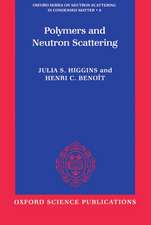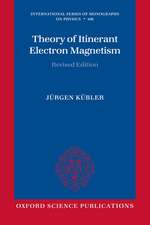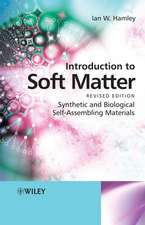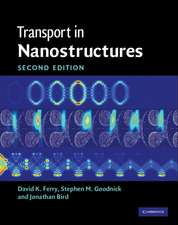Elements of Rapid Solidification: Fundamentals and Applications: Springer Series in Materials Science, cartea 29
Editat de Monde A. Otoonien Limba Engleză Paperback – 7 mar 2012
Din seria Springer Series in Materials Science
- 18%
 Preț: 1820.22 lei
Preț: 1820.22 lei - 18%
 Preț: 776.09 lei
Preț: 776.09 lei - 24%
 Preț: 689.68 lei
Preț: 689.68 lei - 18%
 Preț: 968.96 lei
Preț: 968.96 lei - 20%
 Preț: 568.94 lei
Preț: 568.94 lei - 18%
 Preț: 953.65 lei
Preț: 953.65 lei - 18%
 Preț: 902.36 lei
Preț: 902.36 lei - 18%
 Preț: 953.65 lei
Preț: 953.65 lei - 20%
 Preț: 948.41 lei
Preț: 948.41 lei - 18%
 Preț: 1143.07 lei
Preț: 1143.07 lei - 18%
 Preț: 1111.53 lei
Preț: 1111.53 lei - 18%
 Preț: 1103.62 lei
Preț: 1103.62 lei - 18%
 Preț: 1225.94 lei
Preț: 1225.94 lei -
 Preț: 473.91 lei
Preț: 473.91 lei - 18%
 Preț: 782.42 lei
Preț: 782.42 lei -
 Preț: 433.47 lei
Preț: 433.47 lei - 18%
 Preț: 1116.40 lei
Preț: 1116.40 lei - 18%
 Preț: 946.24 lei
Preț: 946.24 lei - 18%
 Preț: 945.20 lei
Preț: 945.20 lei - 15%
 Preț: 641.20 lei
Preț: 641.20 lei - 18%
 Preț: 958.56 lei
Preț: 958.56 lei - 18%
 Preț: 1224.36 lei
Preț: 1224.36 lei - 15%
 Preț: 644.82 lei
Preț: 644.82 lei - 24%
 Preț: 833.43 lei
Preț: 833.43 lei - 24%
 Preț: 1060.33 lei
Preț: 1060.33 lei - 18%
 Preț: 964.10 lei
Preț: 964.10 lei - 18%
 Preț: 1224.36 lei
Preț: 1224.36 lei - 18%
 Preț: 1221.20 lei
Preț: 1221.20 lei - 18%
 Preț: 946.87 lei
Preț: 946.87 lei - 18%
 Preț: 1842.31 lei
Preț: 1842.31 lei - 15%
 Preț: 643.34 lei
Preț: 643.34 lei - 18%
 Preț: 1246.32 lei
Preț: 1246.32 lei - 18%
 Preț: 956.81 lei
Preț: 956.81 lei - 18%
 Preț: 953.52 lei
Preț: 953.52 lei - 15%
 Preț: 637.59 lei
Preț: 637.59 lei - 24%
 Preț: 1060.87 lei
Preț: 1060.87 lei
Preț: 695.19 lei
Preț vechi: 817.88 lei
-15% Nou
Puncte Express: 1043
Preț estimativ în valută:
133.03€ • 137.24$ • 111.01£
133.03€ • 137.24$ • 111.01£
Carte tipărită la comandă
Livrare economică 26 martie-09 aprilie
Preluare comenzi: 021 569.72.76
Specificații
ISBN-13: 9783642457579
ISBN-10: 3642457576
Pagini: 264
Ilustrații: XIV, 245 p.
Dimensiuni: 155 x 235 x 14 mm
Greutate: 0.37 kg
Ediția:Softcover reprint of the original 1st ed. 1998
Editura: Springer Berlin, Heidelberg
Colecția Springer
Seria Springer Series in Materials Science
Locul publicării:Berlin, Heidelberg, Germany
ISBN-10: 3642457576
Pagini: 264
Ilustrații: XIV, 245 p.
Dimensiuni: 155 x 235 x 14 mm
Greutate: 0.37 kg
Ediția:Softcover reprint of the original 1st ed. 1998
Editura: Springer Berlin, Heidelberg
Colecția Springer
Seria Springer Series in Materials Science
Locul publicării:Berlin, Heidelberg, Germany
Public țintă
ResearchCuprins
1 Introduction and Background.- 1.1 Background.- 1.2 Liquid-to-Crystal Transition: Undercooling and Nucleation.- 1.3 Metallic Glasses.- 1.4 Metastable Crystalline Phases.- References.- 2 Synthesis and Processing.- 2.1 Heat Transfer and Solidification Kinetics.- 2.2 Droplet Methods.- 2.3 Spinning Methods.- 2.4 Surface Melting Technologies.- 2.5 Consolidation Technologies.- References.- 3 Structure and Characterization of Rapidly Solidified Alloys.- 3.1 Characterization Techniques.- 3.2 Total Scattering Intensity from Amorphous and Nanocrystalline Alloys.- 3.3 Diffraction Theory of Powder Pattern Peaks from Nanocrystalline Materials.- 3.4 Experimental Diffraction Techniques.- 3.5 Structure of Amorphous and Nanocrystalline Alloys.- 3.6 Selected Examples of Electron-Microscopy Analysis.- References.- 4 Atomic Transport and Relaxation in Rapidly Solidified Alloys.- 4.1 Basic Equations of Diffusion.- 4.2 Self-Diffusion in Amorphous Alloys.- 4.3 Theory of Diffusion in Disordered Media.- 4.4 Diffusion of Hydrogen Isotopes and Light Particles in Amorphous Alloys.- 4.5 Magnetic After-Effects and Induced Anisotropies Due to Double-Well Systems in Amorphous Alloys.- 4.6 Viscosity and Internal Friction of Amorphous Alloys.- Appendix: Microsectioning by Ion-Beam Sputtering — A Powerful Method to Determine Diffusion Profiles.- References.- 5 Mechanical Properties and Behaviour.- 5.1 Elastic and Anelastic Behaviour.- 5.2 Plastic Flow and Fracture Behaviour.- 5.3 Strength and Hardness.- 5.4 Fatigue and Wear Behaviour.- 5.5 Creep and Hot Deformation Behaviour.- References.- 6 Magnetic and Electronic Properties of Rapidly Quenched Materials.- 6.1 Rapidly Quenched Alloys.- 6.2 Fundamental Magnetic Properties.- 6.3 Domains and Technical Properties of Amorphous Alloys.- 6.4 Magnetism andShort-Range Order.- 6.5 Electronic Structure of Amorphous Alloys.- 6.6 Applications.- 6.7 Conclusion, Outlook.- References.- 7 Chemical Properties of Amorphous Alloys.- 7.1 Corrosion-Resistant Alloys in Aqueous Solutions.- 7.2 Corrosion-Resistant Alloys at High Temperatures.- 7.3 Electrodes for Electrolysis of Aqueous Solutions.- 7.4 Catalysts for Prevention of the Greenhouse Effect and Saving the Ozone Layer.- 7.5 Concluding Remarks.- References.- 8 Selected Examples of Applications.- 8.1 Improvement of Mechanical Properties.- 8.2. Magnetic Applications.- 8.3 Joining Applications.- 8.4 Current Limitations and Future Directions.- Further Reading.- 9 Glossary of Important Terms.
Textul de pe ultima copertă
Elements of Rapid Solidification - Fundamentals and Applications - is the product of many years of concentrated work in the field of rapid solidification and processing. This quasi-monograph is unique in two ways. It brings together the talent of many international scientists in an effort to focus attention on all aspects of a new scientific field and it concentrates on fundamentals and practical applications. Simply stated, this book has been written by the senior students in the field of rapid solidification technology for the new generation of solid-state physicists, materials scientists, materials engineers, metallurgists and ceramicists.


















